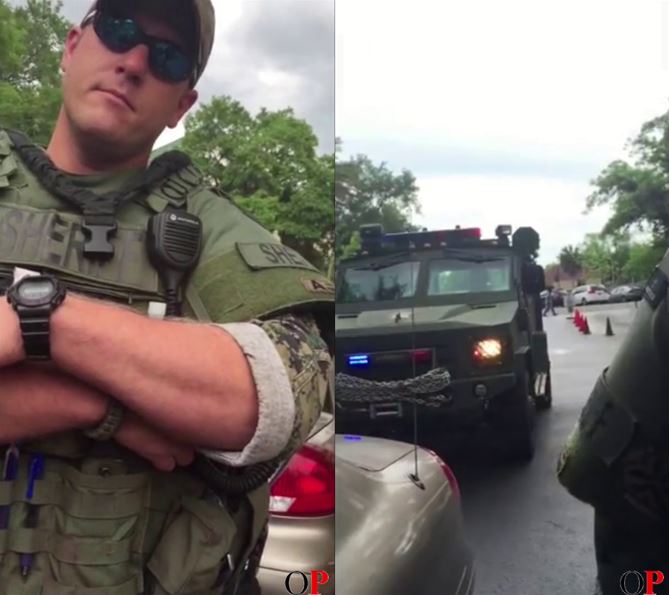
[Last updated on May 18, 2015, at 5:11 p.m.]
Washington – The Obama administration announced Monday it will ban federal transfers of certain types of military-style gear to local law enforcement agencies.
The decision is in response to a spate of incidents that has frayed trust in communities across the country, and after a White House working group made the recommendations.
According to a White House press release, the banned items would include tracked armored vehicles, bayonets, grenade launchers, ammunition of .50-caliber or higher, and some types of camouflage uniforms. Equipment such as tactical vehicles, explosives, and riot equipment, would only be transferred if law enforcement agencies adopt “robust and specific written policies and protocols” covering not just the use of the federal equipment, but their policing practices in general.
Any agency that violates the rules faces being barred from future equipment purchases for at least 60 days and, in some cases, be referred to the Justice Department for a civil rights investigation.
Agencies would also be required to provide additional certification and assurances that prove the gear would not be used in an irresponsible manner.
Officials said that the ban on prohibited items would take effect immediately. However, the restrictions on other gear would be phased in so that law enforcement agencies can be briefed about the new requirements.
According to the White House, citizens “have voiced concerns about what has been described as the ‘militarization’ of law enforcement due to the types of equipment” that is deployed.
A White House spokesperson said that the administration will also spend about $75 million over the next three years to buy about 50,000 body cameras that will be worn by law enforcement.
“The idea is to make sure we strike the right balance of providing equipment that is appropriate and important, while at the same time put standards in place that give a clear reason for the transfer of that equipment, with clear training and safety provisions in place,” White House Director of Domestic Policy, Cecilia Muñoz said.
One of the ways police departments have armed themselves in recent years is through the Defense Department’s excess property program, known as the 1033 Program. That program has transferred more than $4.3 billion in equipment since its inception in 1997. In 2013, [it] gave nearly half a billion dollars worth of military equipment to local law enforcement agencies, according to the program’s web site.
The White House also highlighted one policy by the University of Texas System police that prohibits the use of military vehicles in response to “exercises of the First Amendment right to free speech” or as a part of “any public demonstration or display of police resources.”
The White House working group said they made the recommendations because there is a substantial risk of law enforcement agencies misusing or overusing the military items.
Ocala Post reached out to the Marion County Sheriff’s Office and asked about the agency’s position on the ban.
MCSO released the following statement via e-mail:
“The Sheriff dislikes the ban because of the increased financial burden it places on local law enforcement agencies and their citizens. For example, in the past our agency has received military surplus helicopters for a couple of thousand dollars rather than paying several hundred thousand dollars (even close to a million dollars depending on the unit) to purchase a new helicopter unit. Additionally, we have previously received items such as riot helmets from military surplus. I do want to make clear, however, that there is a common misnomer used in the media about the “militarization” of law enforcement and phrases such as “military equipment.” None of the items our agency has received are offensive in nature, but rather, are defensive (such as helmets needed in the event of a riot to protect the officer’s safety) or items such as a helicopter that is utilized to search for missing persons or to assist law enforcement troops on the ground in various law enforcement functions. By eliminating these surplus items from local law enforcement it means in future years those programs, such as aviation, will either have to be funded by our citizens or scrapped altogether.”
Law enforcement agencies across the county say the equipment is vital for officer safety.
Preliminary statistics released by the FBI on May 11, show that 51 law enforcement officers were killed in the line of duty in 2014. This is an increase of almost 89 percent when compared to the 27 officers killed in 2013. (Note: From 1980–2014, an average of 64 law enforcement officers have been feloniously killed per year. The 2013 total, 27, was the lowest during this 35-year period.) By region, 17 officers died as a result of criminal acts that occurred in the South, 14 officers in the West, eight officers in the Midwest, eight in the Northeast, and four in Puerto Rico.
By circumstance, 11 officers died from injuries inflicted as a result of answering disturbance calls (one of which was a domestic disturbance). Ten officers were conducting traffic pursuits or stops, eight were killed as a result of ambushes (six due to entrapment/premeditated situations and two during unprovoked attacks), and six officers were investigating suspicious persons or circumstances. Five officers sustained fatal injuries while they were performing investigative activities, four while they were engaged in tactical situations, three officers were handling persons with mental illness, and one officer was slain during a drug-related matter. Three officers were killed while attempting other arrests. You can read the entire story on these statistics here.
According to the White House, misuse of military-style vehicles would include using them to conduct traffic stops. The working group said it could be considered a form of intimidation.
A senior administration official said that the White House didn’t have the authority to stop the transfers of military-type equipment. “Those are programs that Congress directed the agencies to implement,” the official said.
Senator Rand Paul (R-Ky.), who has a bill pending in Congress to reform militarized weapons for local police, endorsed the president’s actions.
“I see no reason why a 20-ton mine resistant ambush protection vehicle should ever roll down any city in our country,” Paul said. “The president can change some of this through executive order, and I commend him for doing so. There is no reason that the police force should be the same as the army.”
Senator Claire McCaskill (D-Mo.) also supported Obama’s decision. McCaskill called the new restrictions “another step in the direction of needed change to better protect both police officers and the communities those officers serve.”
Surprisingly, officials said the ban is greatly supported by many who currently and formerly served in the military.

